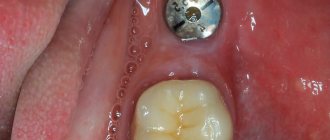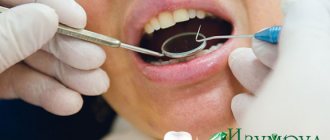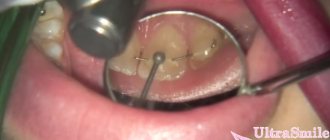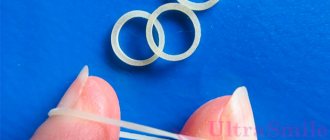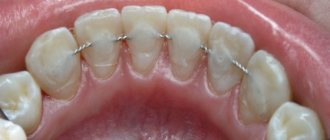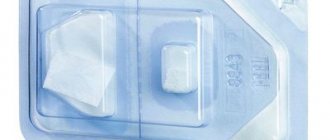In this regard, the results of a recent sociological survey we conducted are of some relevance.
I will be happy to share the data with you. A study of the population's opinion on the need for orthodontic treatment was carried out on the basis of a generalization of data obtained during a survey of patients upon treatment. So.
100 patients (aged 6 to 18 years) or their parents were interviewed.
As it turned out, the reason for visiting the dentist was:
1. Referral from a pediatrician - 42%
:
2. The same number of patients applied on the initiative of their parents - 42%
:
3. Bad tooth - 9%
:
4. Disease of the mucous membrane
membranes of the oral cavity -
3%
:
Considering the growing need of children for orthodontic care, attention is drawn to the fact that of the respondents, the largest number of patients turned to an orthodontist:
- on their own initiative - 62%;
- was referred by a pediatric dentist - 30%,
- referred by a speech therapist -5%.
Unfortunately, these figures indicate that doctors of related specialties do not always pay attention to the presence of dental anomalies in a child.
Orthodontic tooth movement in childhood can be compared to a chess game
. This analogy is valid in many ways.
Let's play with our imagination a little
The game of chess is played with 32 ivory pieces, positioned symmetrically with respect to the center line and divided into two equal parts that are in opposition to each other. Do they look like our teeth? Yes!
The debut of a game is a critical factor in determining its future strategy. Whether the game is won or lost depends on the strategy of moving individual pieces, i.e. ultimately the outcome of the game depends on her opening. Do they look like our teeth? Without a doubt!
William J. Clark , known to most orthodontic specialists.
.
In orthodontics, the analogue of a chessboard is the facial skeleton, which plays a fundamental role, since the main “chess pieces” - our teeth - are located on it. And if you play a chess game with mistakes since childhood, then a new piece may appear on the chessboard - a dental implant
:
But this is already “adult chess” - dental implantation
, and we are not talking about it today.
All about fillings that will help protect teeth and braces from damage
Many patients, when preparing to install braces, hear from friends or read on forums on the Internet stories about the application of overbite fillings, which cause quite severe discomfort, interfere with chewing, closing the jaws and even speaking. After this, people no longer want to wear braces. It's time to dispel all the myths regarding bite fillings and figure out why they are needed and how to use them correctly.
What problems do orthodontic onlays solve?
Occlusal pads reduce the immersion of the prosthesis into the mucosa, thereby preventing compression of the gingival margin of the corresponding supporting teeth.
Other functions of the overlays:
- obstruction of prosthesis settlement;
- unloading the abutment tooth from lateral loads;
- transfer of chewing load from the prosthesis to the supporting teeth.
They also ensure a stable position of the denture on the jaw and prevent the penetration of food into the space between the base and supporting teeth.
What are bite fillings and what are they for?
Overbite fillings are temporary fillings made of various materials. They are one of the auxiliary methods of orthodontic treatment (used in conjunction with wearing a brace system), but are not always used, but only in cases where the clinical situation requires it. They are usually applied to the upper or lower chewing teeth. The material can be applied to only one side or both sides of the dentition; it can also be applied to two or more teeth (fours, fives, sixes and sevens) - depending on the malocclusion.
The main task of such overlays is to protect the bracket system from damage, because its repair is quite expensive. The fact is that with some malocclusions, the upper teeth (usually the front teeth) “go beyond” and touch the orthodontic structure if it is installed on two jaws at once. When chewing, the jaws create quite a strong pressure - 80-100 kg/sq. cm, so if they are closed incorrectly, they can easily damage the braces. Among other things, in such a situation, the teeth themselves, which come into contact with the orthodontic device, can be injured. And bite fillings help avoid the problem.
The application of such an overlay prevents the jaws from closing completely and, accordingly, from touching the structure. After completion of treatment, it is easily removed by the orthodontist and does not damage the enamel.
Modern orthodontic treatment at the Moscow Dental Center
Professional orthodontic treatment of the dentofacial apparatus is carried out by experienced specialists. The latest technologies, modern equipment and high-quality materials are used in diagnostic and treatment procedures. Our center employs pediatric and adult orthodontists. You can make an appointment for a free consultation by phone.
We have affordable prices for all types of dental and orthodontic procedures. Regular clients are provided with discounts on dental services. All patients who leave reviews on the site receive an additional discount of 3% (the discount is added to the client’s main discount).
In what situations is the installation of overbite fillings indicated?
- the upper and lower teeth differ in “dimensions”: usually when the lower ones are abnormally large,
- unilateral or bilateral crossbite diagnosed,
- there are disturbances in the relationship of the arches of the jaws,
- the upper incisors overlap the lower ones too much and thus come into contact with the alveoli of the palate,
- low crowns or the crowns have severe abrasion, or the edge is destroyed: in this case, the filling acts as a temporary measure that increases the height of the worn units. After treatment with braces, the tooth will need to be restored with permanent materials.
That is, all those situations of malocclusion and tooth position are described here in which there remains a risk of damage to either teeth or braces during orthodontic treatment.
Silicone protection
Practice shows that the most common cases in which damage to soft tissues (the inside of the cheeks or the surface of the tongue) occurs include corrective treatment of pronounced malocclusions and dentition development. It requires the installation of complex structures, which are characterized by the presence of a large number of protruding elements - locks, arcs or tubes. It is recommended to cover protruding parts with silicone strips to prevent possible wounds and scratches.
Silicone protection is a set of soft hypoallergenic plates stored in a specially bactericidal container. The flexible structure allows you to use only part of the strip, installing it on the desired element of the braces. The composition of the material is absolutely harmless - even in the event of involuntary ingestion of the protection, no negative or toxic consequences for the body occur. At the same time, doctors recommend removing the system while eating in order to reduce the likelihood of individual elements getting into the stomach.
The use of silicone protection is aesthetically pleasing and practical. Silicone is not visible on the teeth during everyday wear, which allows you to maintain the aesthetics of your smile. At the same time, the installed system not only protects soft tissues from braces, but also reduces the friction force that occurs between the lock and the arch structure, which significantly reduces discomfort and promotes rapid adaptation of the patient.
Materials from which overbite fillings are made
In appearance, they resemble ordinary temporary fillings, only they are larger in size. Depending on what effect needs to be achieved and what features the patient’s jaw has, the doctor chooses an onlay made of one material or another. The most important property is that this element does not damage tooth enamel, but is used as a buffer, but at the same time is strong enough to withstand mechanical stress during chewing. Let's look at the materials that are used for these purposes:
- dentin: it is made from powder - zinc sulfate and zinc oxide, which is mixed with distilled water to achieve the desired consistency. Then this paste is applied to the crown of the tooth, where the material hardens,
- dentin paste: this shock-absorbing agent differs from artificial dentin in that instead of water, oil is used to mix the mass to achieve an antiseptic effect,
- Cement: This stronger material can withstand heavy chewing loads, but it is also not so easy to remove from the crown after wear. Most often, doctors use either polycarboxylate or zinc-phosphorus cements for temporary lining.
- polymers: outwardly resembles a rubber elastic layer, but at the same time provides good adhesion to tooth enamel. The polymer temporary overlay does not require special treatment; it hardens under the influence of special light rays. It is also quite easy to remove from the tooth after use.
Good to know! Such temporary fillings are safe for health, and therefore can be used even when correcting malocclusion in children. Children's options for onlays have different colors, and adult temporary fillings are either white or colorless.
Composition and main varieties
Temporary veneers to protect tooth enamel can be made from a variety of materials and come in different types. Artificial dentin is made from a special composite diluted with water in a certain proportion. This mass can harden in 2-3 hours. Dentin paste is a composite combined with antiseptic additives.
Cement is also often used; it is considered one of the strongest and most durable materials. It is especially popular when identifying a patient with a pathology such as bruxism (teeth grinding during sleep and during severe stress). The orthodontist can also use polymer materials that resemble rubber mass in their appearance and properties.
While wearing the veneers, the patient is advised to adhere to some simple rules regarding oral hygiene and diet. First of all, you should avoid foods that are too hard and chewy, such as nuts, toffees and chewing gum. You will also have to exclude very hot or very cold foods from your menu, such as ice cream. This will not only extend the life of the onlays, but will also preserve the health of your teeth.
previous post
Braces after 40
next entry
How to install the device
The orthodontist takes the appropriate material and simply applies it to the teeth in the required amount, then exposes it to a lamp or other activator. If necessary, the doctor additionally sands off excess material. Does it hurt? No, the procedure is painless, and you can rest assured about the integrity of the teeth on which these types of fillings are placed - the enamel is not subjected to preparation.
How does the withdrawal process work?
The aligners are easily removed from the teeth and must be removed from the mouth for morning and evening care. But a non-removable retainer will have to be removed by a doctor after the braces are removed . But don't rush into this decision. If the product does not bother you, continue wearing it.
Is it possible to remove the wire yourself?
The composite material on which the tape is attached sometimes flies off on its own. Therefore, in theory, the device can be removed independently. But you need to understand that removing a dental retainer without a doctor is a big risk. You can damage the enamel and tooth. Just ask your orthodontist for help, and he will remove the wire in a few minutes.
What sensations accompany patients after installation of structures?
After the procedure, the patient experiences discomfort for some time due to the inability to fully chew food and impaired articulation, because he cannot close his jaws in the usual way. However, in an ideal situation (if the doctor did everything correctly), these unpleasant sensations go away after about a week. Of course, it is impossible to completely eliminate them, but they simply get used to the new position of the jaws. Remember how you felt after fixing your braces – it’s the same here.
Stages of procedure and care
Before applying a filling or installing a plate, the doctor is obliged to conduct a full examination of the patient’s oral cavity, and if pathologies are detected, take measures to eliminate them.
Along with this, the therapist should give an opinion on the general state of health, due to possible contraindications to the procedure.
Next, if a bite plate is installed, an individual impression is made , and the plate itself is made from it. To apply a filling, no special preparation is required other than sanitation of the oral cavity.
To assess the success of treatment and the condition of the fillings, the patient must regularly visit the orthodontist . If non-critical damage to the lining is detected, it is corrected, and in case of extensive defects, it is replaced with a new one.
Fillings and plates require special care throughout the treatment. To preserve their original characteristics and properties, the patient must follow the following rules:
- removable plates are rinsed with running water before each use and disinfected once a week;
- during active recreation or sports, the plate is removed;
- teeth are brushed with a soft brush and toothpaste that does not contain solid abrasive particles;
- To avoid the appearance of an unpleasant odor, it is recommended to treat the plate with special means.
The video shows the principle of operation of overbite fillings.
For what period of time are they installed?
The fillings themselves are temporary; as for the materials from which they are made, they wear out within a few months, after which, if necessary, the doctor applies them again. The material is finally removed after the teeth are in the correct position, or together with the removal of the braces system itself. Therefore, the wearing time for each patient is purely individual and depends on the clinical situation: some wear them for a couple of months, while others wear them for 1.5-2 years.
Placing braces only in a healthy mouth
This principle obliges you to undergo preliminary preparation, which involves sanitation of the oral cavity. Before placing braces you must:
- completely cure all caries and pulpitis;
- remove hard and soft plaque from the surface of teeth and from gum pockets;
- cure all foci of inflammation.
This step cannot be avoided: after installing the system in the mouth, favorable conditions will be created for the formation of plaque. It is necessary that the teeth are resistant to bacteria and do not begin to decay while the brackets are attached to the enamel.
Reviews from real patients about wearing bite fillings
“I’ve been wearing these terrible and huge-sized patches for about five months now. The doctor said that for the rest of the treatment he would have to do this until the upper teeth lined up and took the correct position. It took a long time to get used to it, I was able to chew normally only after a month, I constantly bit my tongue, and my head and jaw also constantly hurt from tension. And there was also an unusual sensation: as if food was stuck in these teeth, it was constantly being tested with its tongue, touching it for the first time. But now the problem has gradually disappeared, apparently, positive changes have begun to occur with the bite.”
Mona, review from woman.ru
“I wore these for eight months. At first, the sensations were not pleasant; my stomach hurt because I swallowed food in pieces and could not chew it properly. Then I got used to it. What’s surprising is that during this time I became so close to them that when they filmed it, it seemed like something was missing.”
Squirrel, from a review from brekety.com
“Throughout the entire treatment process, I was given them four times in a row and all four times I ate them safely. The first time they were placed at the same time as braces on the top of the jaw. I immediately developed a lisp and hurt all my cheeks while trying to eat on the first day, but it was just the braces that got in the way again.”
Demetra, review from the site realbeauty.rf
Functions
The main function of overbite fillings is to prevent damage to the braces system during improper closure of the teeth, when the lower dental arch extends beyond the upper, and vice versa.
Restoring the structure is not a cheap procedure and will require additional time, so the fillings in question are the best solution in this situation.
In addition, these linings perform a number of additional functions:
- reduce pressure on lateral molars , which play a major role in chewing;
- reduce pressure on the soft tissues and bone structure of the periodontal space, thereby protecting against the development of inflammatory processes, caries, periodontal disease and damage to tooth enamel;
- prevent displacement of the braces structure when chewing.
If the teeth are healthy when installing braces, the required amount of material is applied to their surface, which is subsequently easily removed. Teeth that were previously filled or damaged are restored with permanent fillings.
Which method of fixing bracket systems is more reliable? Visit here to find out if you can have an MRI with braces.
At this address https://dr-zubov.ru/ortodontiya/apparaty/brekety/chto-predprinyat-esli-proglotil.html we will tell you what a person needs to do if he accidentally swallows a brace.
Nutrition rules: what you can and cannot eat
The rules here are standard - if you wear braces, you already have to put up with them:
- Eliminate solid foods from your diet to avoid damaging your bite fillings: say no to nuts, whole fruits and vegetables, candies,
- impose a ban on crumbly and sticky foods so that the fillings do not fall out prematurely: you cannot eat cookies, toffees, chips and crackers,
- Avoid food that is too hot or too cold to avoid damaging the integrity of the materials.
At first, during the period of getting used to the structures and when feeling severe discomfort, patients on various forums advise each other to eat soups and purees, as well as dishes crushed using a blender. This is not without meaning, but still it is not worth switching to such food on an ongoing basis - the jaw system must receive a load and function fully.
Crowns
With the help of crowns, chewing and frontal teeth are restored when they are so damaged that installing a filling is no longer possible. Crowns differ in the type of material they are made from.
Metal-ceramic crowns
They have a frame made of precious metals or nickel, cobalt-chrome. The top of the frame is covered with several layers of ceramic composition. Such crowns are quite reliable, however, they are not entirely aesthetic. Due to the metal frame, the tooth may look darker. In addition, an allergic reaction to the metal may occur.
Metal-plastic crowns
In this case, the metal frame is covered with a plastic mass. This significantly reduces the cost of the design and makes it lightweight. It is worth keeping in mind that the service life of a plastic product is not long. In addition, the coating is susceptible to staining and has low strength. Metal-plastic is used as a temporary solution to the problem.
Metal-free crowns
A fairly durable, reliable, aesthetic way to restore teeth. Most often they are used for the frontal region, as they have a similar transparency to their teeth. They are hypoallergenic and have ideal compatibility with soft tissues.
Zirconium dioxide crowns
The most durable and cost-effective method of dental prosthetics. Crowns are made from zirconium dioxide and a layer of ceramic is applied to the base. Used to restore all types of teeth.
What to do if the material breaks off while eating
There is definitely no reason to worry about this. The fillings are made of safe material - they do not injure the stomach and intestines, and will not lead to intoxication and poisoning.
The only thing you need to do if such a situation does occur is to see your doctor, otherwise if the integrity of the filling is damaged, it may begin to crumble and chip further. The orthodontist will quickly correct the situation, repair, adjust or reapply the material.
How the overlays are fixed
Fixation of the filling material is carried out in a dental office. To begin with, the orthodontist prepares the composition, after which he applies the required amount to the teeth, often on both jaws at once, on those elements that come into contact with each other. When using polymer materials, a special LED lamp is used to harden them. At the end of all manipulations, the excess composition is carefully removed - sanded off.
The procedure is completely painless, but problems may arise during the adaptation stage. According to patient reviews, many are faced with pressing questions about how to start eating and talking normally with bite fillings in the mouth. In fact, diction problems and some discomfort at first are completely natural and natural phenomena. There is no need to worry about this, since addiction will still happen. Some people just need a little more time to adapt, others less.
The photo shows a diagram of the installation of a bite filling
How to care for the plates?
In order for the plate to serve the required time and not break, it is necessary to provide it with appropriate care. It is as follows:
- brushing with toothpaste every day;
- disinfection every week;
- storage in a special container, closed;
- oiling the screw;
- removing the plate while eating, brushing teeth, practicing martial arts, boxing and water sports.
Do you dream of beautiful teeth? Contact the orthodontists of the multidisciplinary clinic CELT!
Make an appointment through the application or by calling +7 +7 We work every day:
- Monday—Friday: 8.00—20.00
- Saturday: 8.00–18.00
- Sunday is a day off
The nearest metro and MCC stations to the clinic:
- Highway of Enthusiasts or Perovo
- Partisan
- Enthusiast Highway
Driving directions
Dental plates for children
Having looked at the photos before and after wearing dental plates on children’s teeth, you will conclude that they are very effective - and you will be right. With the right approach, they can be called the best way to correct a number of malocclusions. Their use is advisable under the age of 12 years during active jaw growth. To correct serious anomalies, non-removable structures are used. If there is a slight curvature or prevention is required, removable plates are ideal. As already mentioned, the production of plates is carried out on an individual basis and requires taking impressions and making plaster models. It is very important that the surface relief of the gums and palate coincide exactly. To do this, a special adjustment is carried out, which takes no more than 10 minutes.
Contraindications and side effects
A contraindication for installation is tooth decay, which requires preliminary restoration of the integrity of the walls. Protection is not done if the constituent components are intolerant. Infections of the oral cavity and some endocrine diseases may also be a contraindication to the use of a temporary structure.
On a note!
Often, after installation, patients are faced with the fact that they do not know how to chew food. Discomfort occurs due to the fact that the material does not allow the teeth to close in their previous usual position. The patient needs to be patient. The adaptation period lasts on average 1 – 7 days. After this, the patient gets used to the new conditions, which will still have to be adapted to after the bite is corrected.
What are the disadvantages of dental plates?
The use of records has a number of limitations. First of all, they are due to the fact that the functionality of the plates does not allow them to move teeth. It only makes it possible to hold them in a certain position, which does not allow them to be used to correct serious anomalies. At the same time, it is worth noting that often the reason for the insufficient effectiveness of treatment is a reduction in the time of wearing the structure. As for other disadvantages, these include:
- the need for long-term use;
- a number of uncomfortable sensations during adaptation;
- minimal pressure compared to braces;
- age restrictions for use;
- the need for constant monitoring by parents (in the case of children).
Benefits of orthodontic plates
Although bite plates are only effective for minor malocclusions, they have a number of other benefits:
- Convenient to use. The design of the plates allows you to easily and quickly remove them while eating or brushing your teeth;
- Prompt production. The average production time for plates is from 2 to 4 weeks. At the same time, a removable type structure is manufactured faster than a non-removable one;
- Affordable price. The average price of a plate for correcting a bite is 2 times lower than the price of inexpensive braces.
Design overview
The model and material for the filling are selected taking into account the initial condition of the teeth, the clinical picture and the design features of the braces.
Katz mechanism
The device is a removable plate installed on a fixed jaw and includes the following elements:
- inclined platform (made of plastic);
- reversible tape-type clasps (installed on the front and lateral incisors).
Indicated to correct deep distal occlusion. The principle of operation is to partially immerse the teeth in the alveolar tissue and deflect them towards the lips. Dissociation of the masticatory units has a stimulating effect on alveolar elongation in this area. In other words, the lateral units exit the alveoli and the hard tissues move in a vertical position. As a result of this restructuring, it becomes possible to reduce the depth of the jaw defect.
Khurgina apparatus
The design is the same Katz plate, additionally equipped with an expansion screw. The latter is placed in the center of the bite zone. This solution is effective for the treatment of prognathic occlusion, accompanied by deep occlusion and crowding of the upper units of the oral cavity.
The removable design has a combined effect. The main source of pressure is provided by the contractile function of the masticatory muscles. The inclined surface helps move the lower jaw forward. The horizontal plane promotes the restructuring of the myostatic reflex. The screw force helps to normalize the depth of overlap of the anterior units.
Important! To activate the screw mechanism and correct the site, the patient must visit the orthodontist's office weekly.
The main advantage of an orthodontic device is that it is removable. The structure can be removed for hygiene procedures and disinfection of the oral cavity, as well as for thorough cleaning of the mechanism.


